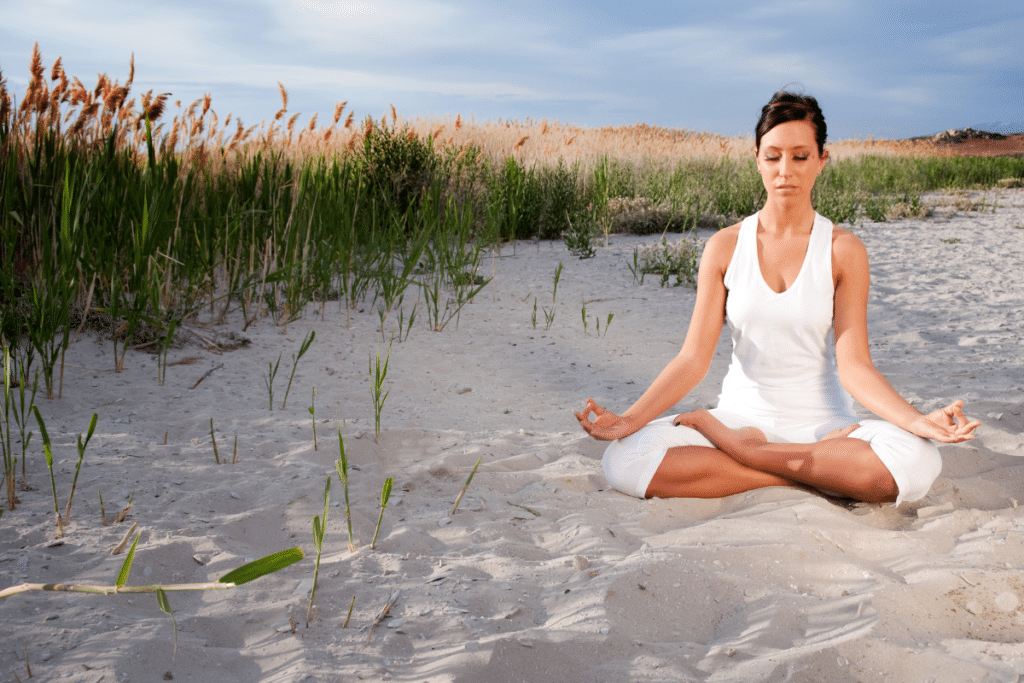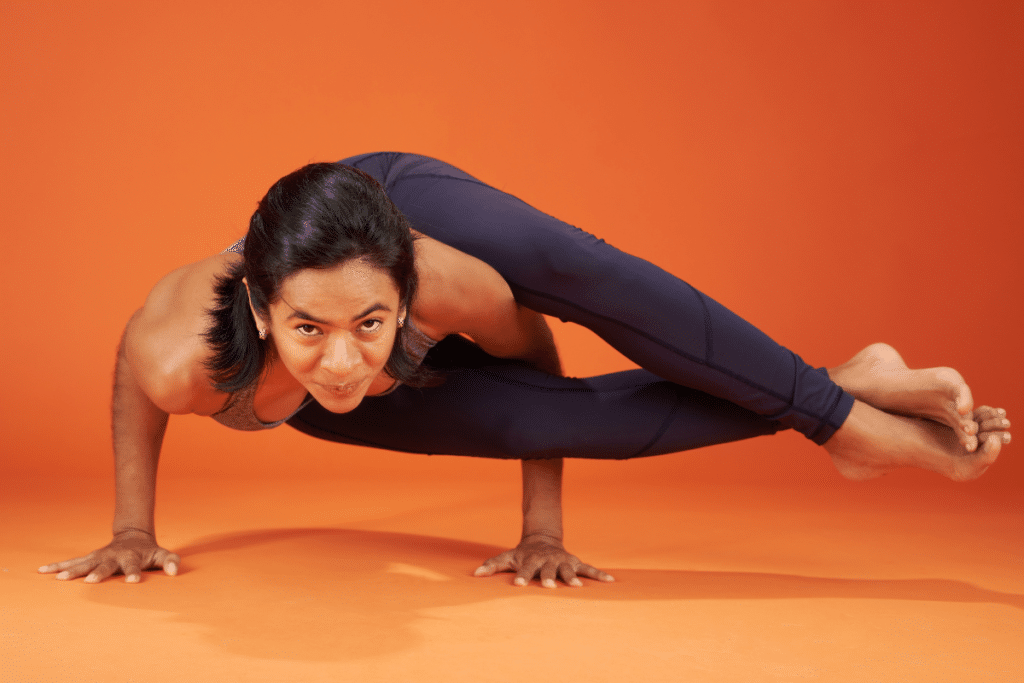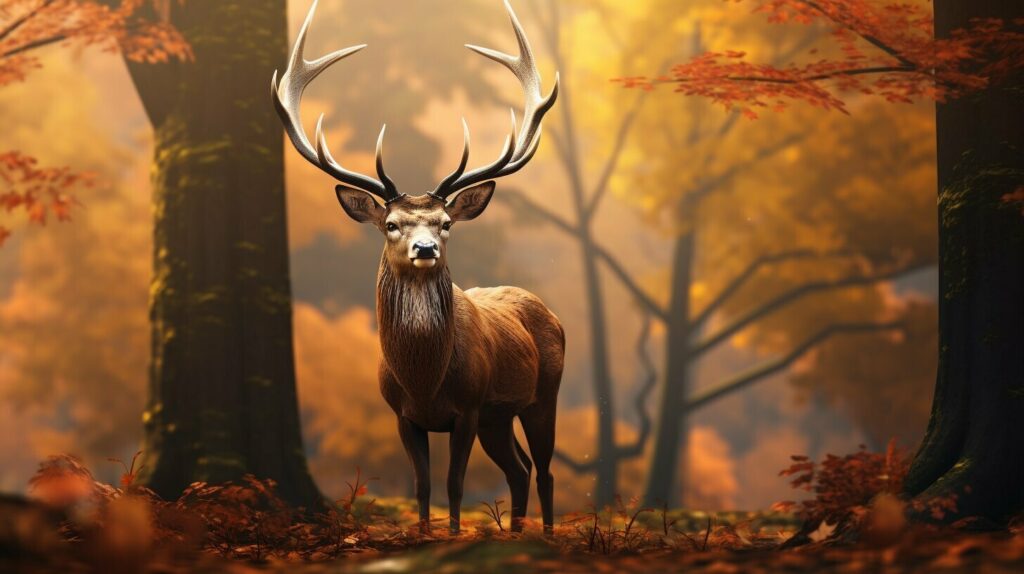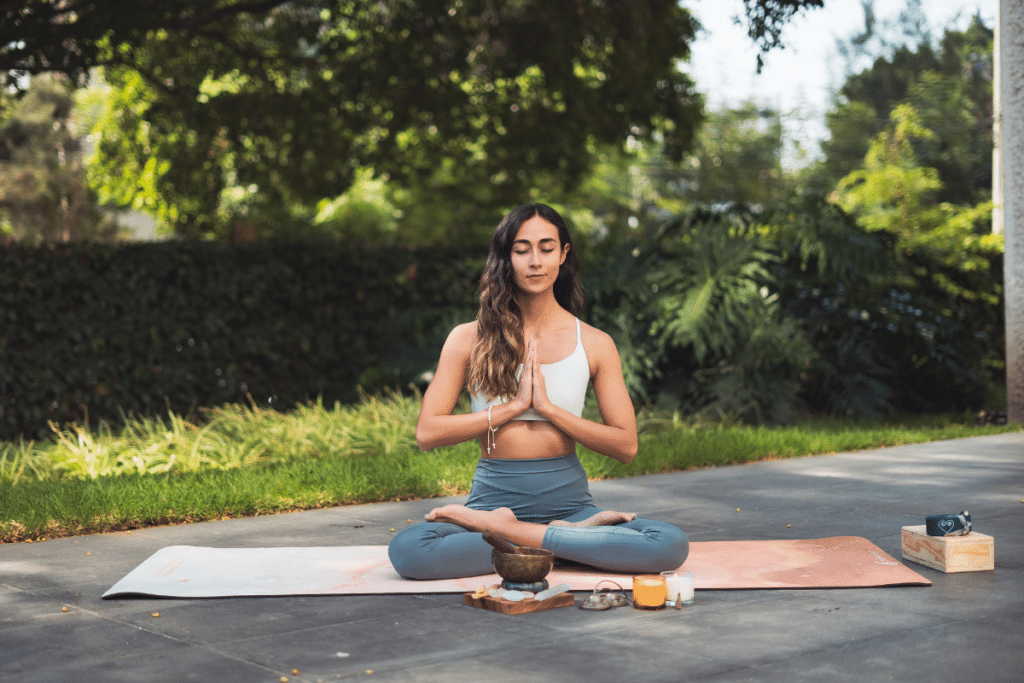Dhyana: Meditation and Contemplation

This series will build on our introduction to Patanjali’s Eight Limbs of Yoga and dive deep into each limb or step on the yogic path to liberation. This article will focus on the eighth limb – Dhyana. But first, let’s have a quick recap of all eight limbs.
The Eight Limbs of Yoga
The Eight Limbs of Yoga is a system of right living (ethics) and practice (techniques) that enables us to control the mind and silence our thoughts so that we can realize the true nature of the Self, thus dissolving the ego into wisdom and attaining Moksha – liberation from suffering.
The Eight Limbs of Yoga are:
- Yama
- Niyama
- Asana
- Pranayama
- Pratyahara
- Dharana
- Dhyana
- Samadhi
To Think, Per Chance to Contemplate
Moving to the seventh limb, we now encounter meditation. Dhyana means ‘to think of.’ But it does not refer to thinking in the usual way. While we are absolutely practicing meditation during the previous ‘concentration’ stage of Dharana, we bring a sense of contemplation when we move into Dhyana. It is this contemplation to which the name ‘to think of’ refers. It is a deeper understanding of the point of focus – whether that be a candle flame, a sound, or the concept of true Self.
Dharana is a single-pointed focus to hold the awareness inwards. In contrast, Dhyana is the point of focus with the added intention of realizing the truth of its nature. It is pure awareness without a single-pointed focus. In Dhyana, we observe without judgment, analysis, or attachment, contemplating the object of our awareness just as it is – as if we had no prior knowledge of it. The object soon loses its shape and form, and becomes the entirety of the experience, in a more abstract and transcendental way.

From Dharana to Dhyana
One of the key points to remember about the difference between Dharana and Dhyana is doing vs. being. Dharana is something that we do, whereas Dhyana is something that we are. Dharana is an action; when practicing it, we consciously choose to maintain a one-pointed focus on an object or experience.
Dhyana is a state of being; it is something that happens following the successful application of Dharana, and the previous limbs. We cannot ‘do’ Dhyana. We can do practices that prepare us for arriving at the experience of Dhyana, but Dhyana itself is something that we are, not something that we do.
While practicing Dharana, we can see that there is a clear separation between the subject (the self) and the object (the point of focus). We practice single-pointed focus, and every time our attention wavers, we consciously bring it back to the object.
When we become adept at this and are able to maintain focus on the object, we become absorbed in the contemplation of the object until there is no longer any separation between the point of focus and the self. There is only a blend of the two, and sensory phenomena, such as thoughts, sounds, and sensations, disappear. We begin the process of unity, which is the fundamental definition of yoga. Thus begins the transition to Samadhi.
Dhyana and Meditation
I think that it is important to note the difference between the practice of meditation and the state of Dhyana. Although these two terms are used interchangeably, they are not the same. Meditation as a practice involves more than one step of the Eight Limbs of Yoga.
Picture the scene: You wake up in the morning and get ready to do your daily meditation practice. You feel a little stiff from lying in bed all night, so you decide to do a few Sun Salutations before you meditate to loosen your muscles and ensure that you are more comfortable. When you’re done, you settle down on your cushion and close your eyes. You take some full deep yoga breaths.
You bring your awareness to your breath, following the natural rhythm and flow of your inhalation and exhalation. You begin counting your breaths, one to ten, repeating the cycle. Every time your attention wanders, you gently bring your awareness back to your breath. After a while, you drop the counting and observe the breath as it is, no judgment or attachment, becoming absorbed in the fullness of your experience. Your timer goes off, and you gently bring yourself out of the practice, ready for your day.
This is a pretty typical meditation session for a lot of people. But this meditation is not simply Dhyana – within this practice, there are actually five of the Eight Limbs of Yoga present. Can you spot them all? Here are the answers:
1: Asana – the sun salutations at the start of the practice
2: Pranayama – the full deep yoga breaths
3: Pratyahara – Closing the eyes, bringing the awareness inward onto the breath
4: Dharana – focusing on the breath, counting the breaths, returning the attention to the breath
5: Dhyana – observation of the breath as it is, becoming absorbed in the experience of the breath
As you can see, Dhyana is a facet of meditation, but meditation practice is not merely Dhyana. We can reach the state of being that is Dhyana during meditation, but, unless we are a meditation master, it is highly unlikely we will sit down and immediately become absorbed in Dhyana.

Preceding Limbs as Preparation
That is the reason for Patanjali’s system. It is a process that we must go through in preparation to enter the higher states of consciousness, such as Dhyana and Samadhi. It is fine to say that your goal is to sit down every day and meditate for 30 minutes, but if you haven’t followed the preparation process that the preceding limbs provide, you will find it very difficult to enter Dhyana.
The Yamas and Niyamas prepare the mind and conscience in order to eliminate distractions and negative mental states. Asana practice prepares the body by making it flexible and minimizing distractions due to pain and discomfort. Pranayama prepares the energy by focusing and redirecting in inwards, as does Pratyahara. Dharana prepares the mind with focused awareness and provides the stepping stone to Dhyana. Only when we have successfully integrated all these facets will we have the mind and body to enter Dhyana.
Dhyana and Divine Consciousness
When we are in the state of being of Dhyana, because the trappings of the ego have slipped away, we enter into a state of pure, unconditional love. The Anahata chakra is active, and our energetic frequency rises. Unconditional love is our natural state of being; we are Divine cosmic energy having a human experience. That human experience includes the ego, which serves to keep us safe, but through that very action, it limits our ability to transcend the human experience and open to our intrinsic nature of Divine consciousness. During Dhyana, we can escape the ego and glimpse the true nature of the soul, unconditional love.
Unconditional love is also one of the three characteristics of enlightenment: unlimited energy and pure awareness. So, when we are able to slip into Dhyana, we are glimpsing one of the facets of Moksha (liberation). If you have ever experienced a feeling of bliss, elation, love, or intense joy during meditation, it is likely you entered into Dhyana.
How to Practice
As stated earlier, Dhyana is a state of being that we can attain if and when we have done enough preliminary preparations and been diligent in our practice of the preceding seven limbs. If so, then the state Dhyana will follow on naturally from the action of Dharana. An effective practice that will lead to Dhyana is as follows:
1: Begin by choosing an object to focus on. Ideally, select something that you know will be easy for you to continue seeing in your mind’s eye after you have closed your eyes. The object could be a candle flame, a statue, a flower, a crystal, or anything else that you have access to and that you are interested in enough to concentrate on for an extended period of time.
2: Study the object in detail, taking in all of its characteristics, its color, shape, texture, form, edges, taking in as much detail as you can.
3: When you are ready, get yourself into a comfortable meditation posture, with your spine straight, and your shoulders relaxed. It is vital that you are as comfortable as possible in order to minimize distractions during your practice. If necessary, do some stretches or a short yoga sequence first to warm up your body and make your muscles feel more supple.
4: Close your eyes and bring your awareness inwards. Take some full deep breaths while concentrating on the flow of your inhalation and exhalation. This step combines Pranayama and Pratyahara. Feel that your mind is relaxing, and your energy is withdrawing inside.
5: Now bring to mind your object from earlier. Picture it in your mind’s eye as if you had your eyes open and were looking at it. This step may take some practice, and some people find visualization like this easier than others, but we are all totally capable of it, even if we need some preliminary training.
6: Study the object as you did before. Notice all the characteristics that you observed when you were looking at it with your eyes open. Each time your attention wanders, bring your mind back to the object, without any negative self-talk. That is simply part of training the mind to focus and concentrate, and we all go through the same process.
7: As you study the object, try to notice the object’s features and qualities without attaching any meaning to them. This can be difficult to begin with because we are taught to analyze and evaluate everything. But as part of this mind training, that investigation must cease. This technique is contemplation without evaluation. It is seeing or experiencing something as it is, without attaching to it any meaning or judgment.
8: As you get better at this, and you are able to keep your focus on the object for a prolonged period of time without analyzing it, you will become more and more absorbed. You will lose the separation between yourself and your object. You will blur the lines that differentiate the two of you until the object completely fills your experience, and you are no longer simply ‘observing’ the object; you have become the object. That is Dhyana.

Conclusion
Remember, Dhyana is not something you can ‘do,’ it is something that you ‘become’ through doing. In order to be successful, you must adequately prepare your body and mind with the preceding limbs; they are there for a reason. As you practice Dharana and become better and better at keeping your concentration on the object of your focus, you will naturally start to move into Dhyana, becoming absorbed in the object with no separation between it and you.
We hope you are enjoying this series on Patanjali’s Eight Limbs of Yoga. If you would like to catch up on the previous articles in this series, here are the links:
The 5 Yamas of Yoga: Universal Morality
The 5 Niyamas of Yoga: Personal Behavior
Asana: The 3rd Limb of Patanjali’s Path to Freedom
Pranayama: 4 Powerful Life Force Extension Methods
Pratyahara: Harness Your Prana for Inner Awakening
Dharana: Concentration and Intense Focus
As always, we are here to assist you on your spiritual journey. If you have any questions or comments on this topic, or anything else related to yoga, meditation, spirituality, or awakening your inner Goddess, please comment below or share with us in the Sacred Circle. This is our forum where you can access the Femigod team of experts and connect with your fellow Goddesses for mutual sharing, encouragement, and support. We hope to connect with you there.







[…] Dhyana: Meditation and Contemplation […]
[…] […]